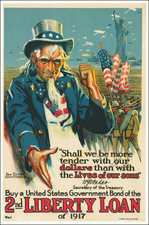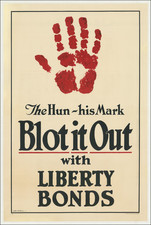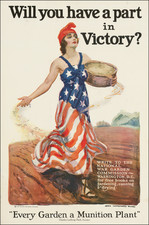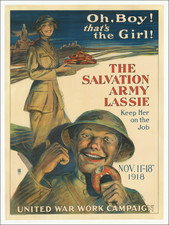1918 Red Cross Recruitment Poster by Famed British-American Artist Albert Sterner
This compelling World War I medical recruitment poster, entitled "We Need You", features the evocative artwork of Albert Edward Sterner. The poster portrays a poignant scene orchestrated with the masterful use of light and shadow, typical of Sterner's renowned draftsmanship. A Red Cross nurse, depicted with a beam of light accentuating her Red Cross uniform, earnestly appeals to a civilian young lady, symbolizing the urgent call for support during the war crisis. This nurse's outstretched arm directs the viewer's attention to the background where another nurse diligently tends to a wounded soldier, whose injuries are wrapped in bandages, illustrating the immediate impact of the war on human lives.
This artwork was created during a time when the American Red Cross, founded in 1881 by Clara Barton, was deeply involved in providing medical care and support services during World War I. The poster not only served as a recruitment tool but also as a public appeal for civilian involvement in the war effort. The Red Cross during this era was a critical organization, enrolling over 29,000 professional nurses, with 20,000 of these serving directly with military forces. The depiction in the poster reflects the dire circumstances of wartime medical care and the heroic efforts of nurses who operated under often primitive conditions to save lives.
Sterner’s work captures the essence of the Red Cross's mission and the vital role of nurses during the war, emblematic of the broader humanitarian spirit that pervaded the American home front. The artwork is imbued with emotional depth, illustrating not just the physical demands placed on these women but also the moral and emotional appeal to the public’s conscience. The poster's design and its effective use of visual narrative helped galvanize support and recruit thousands of volunteers for the Red Cross, contributing significantly to the home front efforts during the global conflict.
The imagery used by Sterner in this poster remains a powerful reminder of the sacrifices and contributions of medical personnel in times of war. It reflects the critical role of visual arts in wartime propaganda and recruitment, serving as both a historical document and a piece of art that communicates the universal themes of duty, sacrifice, and compassion. This poster, therefore, not only captures a moment in history but also exemplifies how art can move public sentiment and mobilize communities for a common cause.
Albert Edward Sterner (March 8, 1863 – December 16, 1946), a distinguished British-American artist, carved a unique space in the intersecting worlds of painting, printmaking, and illustration. Renowned for his adept and fluid draftsmanship, Sterner's artistic journey is marked by critical engagements with major periodicals such as Century Magazine, Harper's, and Life, where he not only contributed but shaped the visual culture of his time.
Born into a Jewish family in London, Sterner's formative years were influenced by diverse cultural experiences across Europe. He attended King Edward's School in Birmingham, followed by studies in Germany. His artistic talents were honed under the tutelage of Jean-Léon Gérôme and Gustave Boulanger at the prestigious studios in Paris. In 1879, he migrated to the United States, settling in Chicago where his family had established themselves earlier, and where his brother, Frederick Sterner, would later emerge as a noted architect.
Sterner's opened his own studio in New York in 1885, marking the start of a prolific period of contributions to leading magazines. His artistic education continued at the Académie Julian in Paris in 1888, further solidifying his skills. Sterner’s illustrations for works like G.W. Curtis' Prue and I and the Works of Edgar Allan Poe underscored his reputation as a premier black-and-white artist. His painting, "The Bachelor", exhibited at the 1900 Paris Exposition, won him a bronze medal, affirming his place in the international art scene.
Returning to America in 1918, Sterner began teaching at the Art Students League of New York, influencing a generation of artists. His work during this period diversified into nudes, religious themes, landscapes, and still-life, reflecting a broadening of his artistic repertoire. Notably, his portraits of eminent patrons like the Vanderbilts, Whitneys, and Wideners earned him immense acclaim.
Sterner's works were exhibited at prestigious institutions such as the Pennsylvania Academy of the Fine Arts, Carnegie Museum, and the Art Institute of Chicago. His career was punctuated with accolades, including the Carnegie Prize at the National Academy of Design in 1941, which celebrated his enduring influence on American art.
Albert Sterner's legacy is preserved not only through his artworks but also through his impact on students like Elizabeth Cady Stanton Blake and Jacob Burck, who carried forward his artistic ethos. His ability to blend European techniques with American sensibilities made him a pivotal figure in the art world of his time, bridging the gap between the traditional and the modern, the classical and the contemporary. His death in 1946 was noted by the New York Times as the loss of a luminary best known for his portraits and diverse subject matter, attesting to a life devoted to the pursuit of artistic expression and education.














![(Prussian Octopus) En 1788 Mirabeau disait deja: La Guerre est l’industrie Nationale de la Prusse [Already in 1788 Mirabeau was saying: War is the national industry of Prussia]](https://storage.googleapis.com/raremaps/img/small/76554.jpg)

